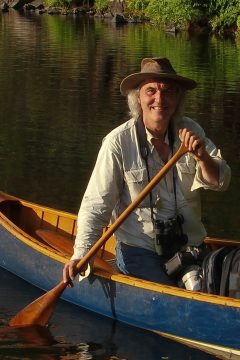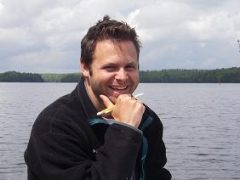 Michael Runtz |
“Careers in Biology: Thinking outside the Bog”
Michael Runtz was an interpretive naturalist for many years, in both Algonquin Provincial and Point Pelee National parks. Michael has conducted several major biological surveys across Ontario, hosted an international television series Wild by Nature, written more than 1,000 newspaper and magazine natural history articles, and published 10 bestselling books on natural history topics that feature his award winning photography. His 11th, Dam Builders: the natural history of beavers and their ponds, will be released in April. Since 1988, Michael has taught at Carleton University in the Department of Biology, and he has been recognized with numerous awards, including a Federation of Ontario Naturalists’ Service Award, The Friends of Algonquin Park Directors Award, the Canadian Council of University Biology Chairs Distinguished Public Education Award, and the Carleton University Lifetime Achievement Award. |
 Dr. Ken Storey |
Ken Storey, PhD, FRSC, is a Professor of Biochemistry at Carleton University and holds the Canada Research Chair in Molecular Physiology. His career has focused on biochemical adaptation – the unique solutions that allow animals that endure whole body freezing, live for weeks without oxygen, or hibernate all winter. Recently Ken won the 2010 Flavelle medal from the Royal Society of Canada and the 2011 Fry medal from the Canadian Society of Zoologists. For more information visit www.carleton.ca/~kbstorey.
Abstract of Dr. Storey’s Talk The “Edges of Life” have fascinated thinkers from the time of Aristotle. Environmental extremes trigger extreme animal responses. Stresses, from drying to freezing to oxygen deprivation to extreme heat or cold can trigger ‘the living dead” – animals that are alive but show no apparent life signs. For example, from our own perspective as homeotherms that are severely injured if core body temperature drops below ~25°C, it is amazing to think about hibernation – mammals descending into a deep torpor and letting their bodies chill to near 0°C. Nature has set in place complex mechanisms to allow animals to “turn down the fires of life” – the basic framework is present in every organism but discovering the biochemical secrets of how to do this is the challenge. Our lab studies the molecular mechanisms that control metabolic rate suppression. We have identified multiple adaptive strategies that regulate transitions to and from hypometabolism and maintain viability over prolonged dormancy. These include differential gene expression, altered cell signaling pathways, and changes to enzyme properties to alter their function during hypometabolism. This talk will summarize our recent work on the molecular mechanisms of metabolic arrest in mammalian hibernation. Startling similarities exist in basic mechanisms of hypometabolism across phylogeny – indicating, perhaps, that torpor was a basal characteristic of mammals. You, as a human, may have just “forgotten” this skill. |
 Dr. Steven Cooke |
Dr. Steven Cooke, Canada Research Chair and Associate Professor, Department of Biology and Institute of Environmental Science, Carleton UniversityFish and aquatic resources around the globe face threats related to human activities and environmental change. Cooke and his team conduct interdisciplinary research related to the conservation and science-based management of aquatic resources as well as the fundamental biological processes that underlie impacts of stressors on individuals and fish populations. Cooke has published over 400 peer reviewed papers on topics ranging from conservation social science and stakeholder engagement to behavioural endocrinology and comparative biochemistry. Cooke has received a number of awards including the Medal from the Fisheries Society of the British Isles, the Roderick Haig-Brown Award from the Canadian Wildlife Federation and the NSERC E.W.R. Steacie Memorial Fellowship. Cooke is Past-President of the Canadian Aquatic Resources Section of the American Fisheries Society and is Editor-in-Chief for the journal “Conservation Physiology. |
 Dr. Em Standen |
Em Standen is a new professor at the University of Ottawa with a research focus on comparative and evolutionary biomechanics. Em has always been fascinated by fish. She did her undergraduate degree in marine biology and oceanography at Dalhousie University before working for the fisheries research branch of the government of British Columbia. That led her to complete a MSc at the University of British Columbia where she tracked salmon up the Fraser River trying to understand how they managed to swim through such turbulent water with limited energy stores. This research took her to the Lauder Lab at Harvard University where she completed her PhD trying to sort out how fish use their fins during swimming. Fish fin use during swimming combined with a dynamic evolutionary biology department got her questioning how the flexibility of fins in an aquatic environment might extend into a terrestrial environment. As an NSERC and Tomlinson postdoctoral fellow at McGill University she tested just that, raising fish on land and measuring their biomechanical and anatomical plasticity. She continues to study how novel environments influence functional morphology, particularly in fishes.
Abstract of Dr. Standen’s talk: “How to walk like a fish” Approximately 400 years ago our fishy ancestors started to move out onto land. This transition was accompanied by the origin of terrestrial locomotion. How early fishes might have used their fins to navigate terrestrial environments is not clear from the fossil record. By choosing a living fish similar in body form to the fossil fish paleontologists think led to the first tetrapods we hoped to better understand how fossil fishes might have used their fins to walk. We raised Polypterus senegalus on land and measured their anatomical and biomechanical plasticity. Our data show a remarkable correspondence between the environmentally induced phenotypes of terrestrialized Polypterus and the ancient anatomical changes in stem tetrapods, providing insight into stem tetrapod behavioural evolution. We also show that Polypterus have three distinct terrestrial gaits. Our results raise the possibility that biomechanical variation as well as environmentally induced developmental plasticity facilitated the origin of the terrestrial traits that led to tetrapods. |